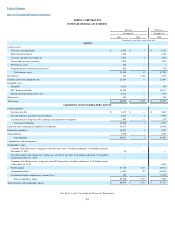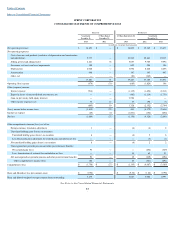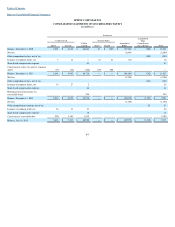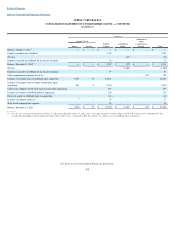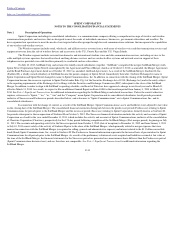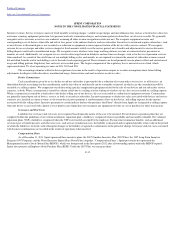Sprint - Nextel 2013 Annual Report Download - page 130
Download and view the complete annual report
Please find page 130 of the 2013 Sprint - Nextel annual report below. You can navigate through the pages in the report by either clicking on the pages listed below, or by using the keyword search tool below to find specific information within the annual report.
Table of Contents
Index to Consolidated Financial Statements
SPRINT CORPORATION
NOTES TO THE CONSOLIDATED FINANCIAL STATEMENTS
These estimates are inherently subject to judgment and actual results could differ. Allocations of the purchase price for acquisitions or mergers are
based on estimates of the fair value of the net assets acquired as discussed above, and are subject to finalization of the purchase price allocation during the
measurement period. During the measurement period, the Company will adjust assets and liabilities if new information is obtained about facts or circumstances
that existed as of the acquisition date that, if known, would have changed the recognition and/or measurement of those assets and liabilities as of that date. All
changes that do not qualify as a measurement period adjustment will be included in current period earnings.
Certain prior period amounts have been reclassified to conform to the current period presentation. Subsequent events were evaluated for disclosure
through the date on which the financial statements were filed with the SEC.
Summary of Significant Accounting Policies
Cash and Cash Equivalents
Cash equivalents generally include highly liquid investments with maturities at the time of purchase of three months or less. These investments may
include money market funds, certificates of deposit, U.S. government and government
-
sponsored debt securities, corporate debt securities, municipal securities,
bank
-
related securities, and credit and debit card transactions in process.
Allowance for Doubtful Accounts
An allowance for doubtful accounts is established to cover probable and reasonably estimable losses. Because of the number of subscriber
accounts, it is not practical to review the collectibility of each of those accounts individually to determine the amount of allowance for doubtful accounts each
period, although some account level analysis is performed with respect to large wireless and wireline subscribers. The estimate of allowance for doubtful
accounts considers a number of factors, including collection experience, aging of the accounts receivable portfolios, credit quality of the subscriber base and
other qualitative considerations, including macro
-
economic factors. Amounts written off against the allowance for doubtful accounts, net of recoveries and
other adjustments, were
$98 million
for the Successor year ended
December 31, 2013
and
$374 million
,
$549 million
, and
$519 million
for the Predecessor 191
-
day
period ended July 10, 2013 and years ended
December 31, 2012
and
2011
, respectively.
Device and Accessory Inventory
Inventories are stated at the lower of cost or market. Cost is determined by the first
-
in, first
-
out (FIFO) method. Costs of devices and related revenues
generated from device sales (equipment net subsidy) are recognized at the time of sale. Expected equipment net subsidy is not recognized prior to the time of
sale because the promotional discount decision is generally made at the point of sale and because the equipment net subsidies are expected to be recovered
through service revenues.
The net realizable value of devices and other inventory is analyzed on a regular basis. This analysis includes assessing obsolescence, sales
forecasts, product life cycle, marketplace and other considerations. If assessments regarding the above factors adversely change, we may be required to sell
devices at a higher subsidy or potentially record expense in future periods prior to the point of sale.
Property, Plant and Equipment
Property, plant and equipment (PP&E), including improvements that extend useful lives, are recognized at cost. Depreciation on property, plant and
equipment is generally calculated using the straight
-
line method based on estimated economic useful lives of
3
to
30
years for buildings and improvements and
network equipment, site costs and related software and
3
to
12
years for non
-
network internal use software, office equipment and other. Leasehold
improvements are depreciated over the shorter of the lease term or the estimated useful life of the respective assets. We calculate depreciation on certain
network assets using the group life method. Accordingly, ordinary asset retirements and disposals on those assets are charged against accumulated
depreciation with no gain or loss recognized. Gains or losses associated with all other asset retirements or disposals are recognized in the consolidated
statements of comprehensive loss. Depreciation rates for assets are revised periodically to account for
F
-
12




